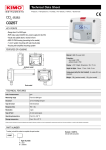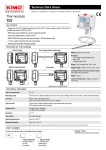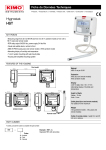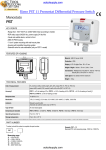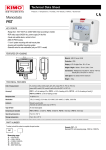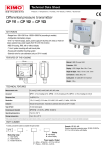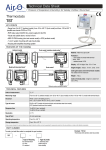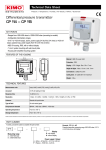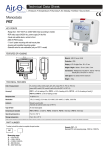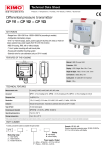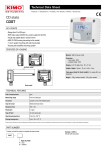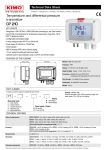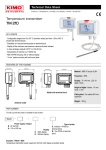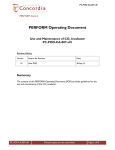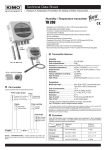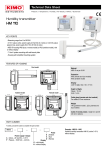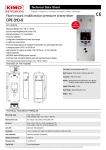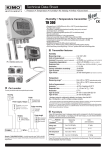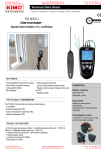Download Stats
Transcript
Thermostats TST KEY POINTS - Range from 0 to 50 °C (ambient model), from -20 to +80 °C (duct model) and from -100 to 400 °C (modèle avec bornier Pt100 ou CTN) - RCR relay output 3A/230 Vac, power supply 24 Vac/Vdc - Visual and audible alarm, red led in front - ABS V0 IP65 housing (duct and remote model) or IP20 (ambient model) - “¼ turn” system mounting with wall-mount plate - Housing with simplified mounting system FEATURES OF THE HOUSING Ambient model Duct model, stainless steel probe* 46 mm 90 mm 150 mm Material : ABS V0 as per UL94 109 mm 90 mm 80 mm 41 mm Ø6 mm Protection : - duct model and model with terminal block : IP65 - ambient model : IP20 Display : LCD 10 digits. Size : 50 x 17 mm Model with terminal block* Duct model* 90 mm 46 mm 112 mm Height of digits : Values : 10 mm ; Units : 5 mm 90 mm Cable gland (duct and terminal block models) For cables Ø 8 mm maximum 109 mm 109 mm 46 mm Weight : 162 g Cable of remote probe : length 2 m and Ø 4.8 mm in PVC *different probes available as option TECHNICAL FEATURES Units of measurement °C, °F Measuring range From 0 to 50 °C (ambient model), from -20 to +80 °C (duct model) and from -100 to +400 °C (model with terminal block) Accuracy* Pt100 : ±0.5 % of reading ±0.5 °C NTC : ±0.3°C (from -40°C to 70°C) ; ±0.5°C outside Type of sensor Pt100 or NTC (model with terminal block and stainless steel duct model) NTC (ambient model and duct model) Response time 1/e (63%) 5 sec. (ambient) 1/e (63%) 20 sec. (airtight) Resolution 0.1 °C Type of fluid Air and neutral gas Operating temperature From 0 to +50 °C Storage temperature From -10 to +70 °C All the accuracies indicated in this technical datasheet were stated in laboratory conditions, and can be guaranteed for measurements carried out in the same conditions, or carried out with calibration compensation. * PART NUMBER To order, just add the codes to complete the part number : TST Type of housing B : terminal block A : duct S : ambient Type of probe I : stainless steel probe (only for duct models) Example : TST-AI Thermostat with stainless steel duct probe TECHNICAL SPECIFICATIONS Output 1 RCR relay 3 A / 230 Vac Power supply 24 Vac/Vdc ±10 % Consumption 2 VA Relay and alarm status Red led in front and internal buzzer Electromagnetical compatibility EN61326 Electrical connection Terminal block for cables Ø0.05 to 2.5 mm2 PC communication USB-mini Din Kimo cable Environment Air and neutral gases CONNECTIONS Inside the front housing Fixed back housing Removable front face Power supply terminal block Relay terminal block LCC-S connection Inactive Active switch switch Button for settings Alarm led Cable gland ELECTICAL CONNECTIONS – as per NFC15-100 standard This connection must be made by a qualified technician. To make the connection, the transmitter must not be energized. NO COM NC 1 2 3 4 6 5 - 6 ~ N 7 N ~ + Power supply 24 Vdc 7 ~ L or L ~ Power supply 24 Vac Class II SETTINGS AND USE OF THE TRANSMITTER ➢ Configuration To configure the transmitter, it must not be energized. Then, you can make the settings required, with the DIP switches (as shown on the drawing below). When the transmitter is configured, you can power it up. ➢ Units setting – active switch On-off switch 1 2 3 4 Units setting °C Configurations To set a unit of measurement, put the on-off switch 4 of the units as shown beside. Combinations 1 2 3 4 °F 1 2 3 4 ➢ Thresholds configuration The button allows to activate or not an alarm (threshold), to set the action of the alarm (edge), to set the threshold(s) value, to set the time-delay and to acknowledge the alarm. Working principle : ● By pressing on the button more than 3 seconds, you can validate the setting and go to the next setting. ● By pressing quickly on the button, you can increment a value and scroll down the different option or values. Setting procedure : ● Activate or deactivate an alarm : ➢ Press on the button for 3 seconds, “CONF” is displayed then “NEG”, meaning that the relay is in negative security, it is excited during an alarm condition. ➢ If needed, press quickly on the button to switch the relay in positive security, the relay is de-energized during an alarm condition or a current breaking, “POS” is displayed. ➢ Press 3 s on the button, “Alarm” screen is displayed with “On” or “Off” blinking (according to the last saved configuration). ➢ Press quickly on the button, the display changes from “On” (activated alarm) to “Off” (deactivated alarm). ➢ Press 3 seconds on the button to confirm the setting. If the alarm is deactivated, the instrument displays the measurement ; if the alarm is activated, the instrument displays the following setting. ● Set the action of the alarm (rising edge or falling edge) The edge determines the action of the alarm according to the trespassing direction of the threshold(s). Mode Rising edge (1 threshold) : the alarm goes off when the measurement exceeds the threshold and stops when it is below the threshold. Mode Falling edge (1 threshold) : the alarm goes off when the measurement is below the threshold and stops when it exceeds the threshold. Mode Monitoring (2 thresholds) : the alarm goes off when the measurement is outside the defined low and high thresholds. Falling edge Rising edge Measurement (m) > Threshold (S) during the time-delay T1 → Alarm activation. Measurement (m) < Threshold (S) - Hysteresis (H) during the timedelay T2 → Alarm deactivation. Measurement (m) < Threshold (S) during the time-delayT1 → Alarm activation. Measurement (m) > Threshold (S) + Hysteresis (H) during time-delay T2 → Alarm deactivation. Monitoring The alarm goes off when the measurement is outside the low and high thresholds. ➢ Press briefly on the button to select the trespassing direction then press the button more than 3 seconds to validate this direction and set the thresholds. Set the threshold(s) value The first digit blinks, it corresponds to the positive (0) or negative (-) setting of the threshold value. Press briefly on the button to select the sign for the threshold value. Press on the button more than 3 seconds to validate. The second digit blinks, press briefly on the button to scroll the numbers. Press the button more than 3 seconds to validate. Repeat the process until the last digit to configure the threshold value, validate the threshold and go to the following setting. If the monitoring edge has been selected, the transmitter displays the setting of the second threshold. ● Set the hysteresis The hysteresis is only for the rising edge and the falling edge modes. In rising edge mode, the hysteresis allows to the transmitter to stay in alarm when the measurement is between the threshold and the threshold minus the hysteresis. Ex : for a 70 °C threshold and a 10 °C hysteresis, the instrument will stay in alarm when the measurement will be between 70 and 60 °C. In falling edge mode, the hysteresis allows to the transmitter to stay in alarm when the measurement is between the threshold and the threshold plus the hysteresis. Ex : for a 70 °C threshold and a 10 °C hysteresis, the instrument will stay in alarm when the measurement will be between 70 and 80 °C. The first digit blinks, set it pressing the button briefly several times then press on the button more than 3 seconds to set the following digit.. Once the hysteresis is set, press the button more than 3 seconds to validate and set the time-delays. ● Set the time-delay 1 and the time-delay 2 (600 seconds maximum) ➢ In rising edge mode, the time-delay 1 corresponds to the time lag before the alarm goes off when the threshold has been reached. The time-delay 2, corresponds to the time lag before the alarm stops when the measurement is lower than the threshold minus the hysteresis. Setting procedure : “Time 1” for the time-delay 1 is displayed then the time in second. The first digit blinks, press briefly on the button and scroll the figures. Press on the button more than 3 seconds to validate. Repeat the process until the last digit to set the time-delay 1 value (from 0 to 600 s) and validate. “Time 2” is displayed the the time in second. Repeat the process to set the time-delay 2. ➢ In falling edge mode, the time-delay 1 corresponds to the time lag before the alarm goes off when the threshold has been reached. The time-delay 2, corresponds to the time lag before the alarm stops when the measurement is lower than the threshold plus the hysteresis. The setting procedure is the same as the rising edge procedure. ➢ In monitoring mode, the alarm of the transmitter goes off when the measurement is below the lower threshold and higher the high threshold. The timedelay 1 corresponds to the time lag before the alarm goes off when the measurement is below the lower threshold and higher the high threshold. The time-delay 2 corresponds to the time lag before the alarm stops when the measurement is between the lower and higher thresholds. The setting procedure is the same as the rising edge procedure. ● CONFIGURATION VIA LCC-S SOFTWARE (option) 1 2 3 4 The software allows to set the alarms, the thresholds, and the time-delay of the transmitter. • To access the configuration via software : - Set the DIP switches as shown beside. - Connect the cable of the LCC-S to the connection of the transmitter. • Please refer to the user manual of the LCC-S to make the configuration. Active switch The configuration of the parameters can be done either with the DIP switch or via software (you can not combine both solutions). 75 MOUNTING 37.5 40 23.75 To mount the transmitter, mount the ABS plate on the wall (drilling : Ø6 mm, screws and pins are supplied). Insert the transmitter on the fixing plate (see A on the drawing beside). Rotate the housing in clockwise direction until you hear a “click” which confirms that the transmitter is correctly installed. A 7.5 MAINTENANCE Please avoid any aggressive solvent. Please protect the transmitter and its probes from any cleaning product containing formalin, that may be used for cleaning rooms or ducts. OPTIONS AND ACCESSORIES ● ● ● KIAL-100A : Power supply class 2 , 230 Vac input, 24 Vac output LLCC-S : configuration software with USB cable Stanliess steel Pt100 2 or 3 wires probes or NTC probes for duct models and remote models available on request 68 4.5 14 50 Ambient model has not any fixing plate. 4 fixing holes are inside the back housing. Use them to install the transmitter on the required location. 8 A FTang – transmitter_TST – 10/04/13 – RCS (24) Périgueux 349 282 095 Non-contractual document – We reserve the right to modify the characteristics of our products without prior notice. The setting of time delays is done, the measurement is displayed. Manostats PST KEY POINTS - Range from -100/+100 Pa to -2000/+2000 mbar (according to model) - RCR relay output 3A/230 Vac, power supply 24 Vac/Vdc - Visual and audible alarm, red led in front - ABS V0 IP65 housing - “¼ turn” system mounting with wall-mount plate - Housing with simplified mounting system - Solenoid valve for auto-calibration (only on PST11 model) FEATURES OF HOUSING 90 mm 46 mm Material : ABS V0 as per UL94 Protection : IP65 109 mm Display : LCD 10 digits. Size : 50 x 17 mm Height of digits : Values : 10 mm ; Units : 5 mm Connections : Ribbed Ø 6.2 mm (PST11 - PST12 - PST13) Security Ø 6.2 mm (PST14 - PST15) Cable gland : for cables Ø 8 mm maximum Weight : 143 g TECHNICAL FEATURES Unit of measurement Pa, mmH2O, inWG, mmHG, daPa, kPa, hPa, mbar (PST-11, PST-12, PST-13) mbar, inWG, mmHG, PSI, mmH2O, daPa, hPa, kPa (PST-14, PST-15) Accuracy* PST11 : ±1% of reading ±2 Pa ; PST12 : ±1.5% of reading ±3 Pa ; PST113 : ±1.5% of reading ±3 mmH2O PST14 and PST15 : ±1.5% of reading ±3 mbar Response time 1/e (63%) 0.3 s Resolution 1 Pa ; 0.1 mmH2O ; 0.01 mbar ; 0.01 inWG ; 0.01 mmHG ; 0.1 daPa ; 0.001 kPa Autozero Manual by push-button Automatic by solenoid valve (only on PST11) Type of fluid Air and neutral gases Overpressure tolerated PST11, PST12 : 21 000 Pa ; PST13 : 69 000 Pa ; PST14 : 1400 mbar ; PST15 : 4100 mbar Operating temperature From 0 to +50 °C Storage temperature From -10 to +70 °C *All the accuracies indicated in this technical datasheet were stated in laboratory conditions, and can be guaranteed for measurements carried out in the same conditions, or carried out with calibration compensation. PART NUMBER To order, just add the codes to complete the part number : PST Measuring range 11 : -100/+100 Pa 12 : -1000/+1000 Pa 13 : -10 000/+10 000 Pa 14 : -500/+500 mbar 15 : -2000/+2000 mbar Example :PST – 13 Manostat PST with measuring range -10000 to +10000 Pa TECHNICAL SPECIFICATIONS Output 1 RCR relay 3 A / 230 Vac Power supply 24 Vac/Vdc ±10 % Consumption 2 VA Relay and alarm status Red led in front and internal buzzer Electromagnetical compatibility EN61326 Electrical connection Terminal block for cables Ø0.05 to 2.5 mm2 PC communication USB-mini Din Kimo cable Environment Air and neutral gases CONNECTIONS Inside the front housing Fixed back housing Removable front face Switchs Solenoid valve (only PST-1) Power supply terminal block Relay terminal block Autozero LCC-S connection Button for settings Alarm led Cable gland Pressure connections ELECTICAL CONNECTIONS – as per NFC15-100 standard This connection must be made by a qualified technician. To make the connection, the transmitter must not be energized. NO COM NC 1 2 3 4 6 5 - 6 ~ N 7 N ~ + Power supply 24 Vdc 7 ~ L or L ~ Power supply 24 Vac Class II SETTINGS AND USE OF THE TRANSMITTER ➢ Autozero To perform an autozero, unplug the 2 pressure connections tubes and press the “Autozero” key. On the PST11 transmitter, it is not necessary to unplug the 2 pressure connection tubes. When an autozero has been performed, “On” green light turns off then turns on, and “autoZ” is displayed. ➢ Configuration To configure the transmitter, it must not be energized. Then, you can make the settings required, with the DIP switches (as shown on the drawing below). When the transmitter is configured, you can power it up. To configure the transmitter, unscrew the 4 screws from the housing then open it. DIP switches allowing the different settings are then accessible. On-off switch 1 2 3 4 Right DIP switch Units setting ➢ Units setting – right DIP switch To set a unit of measurement, put the 1, 2 , 3 and 4 on-off switches as indicated in the table below. PST11, PST12, PST13 : Configurations Combinations mmH2O Pa 1 2 3 4 1 2 3 4 1 2 3 4 mbar InWG 1 2 3 4 mmHG daPa 1 2 3 4 1 2 3 4 kPa hPa 1 2 3 4 1 2 3 4 PST14, PST15 : Configurations Combinations ➢ mbar inWG 1 2 3 4 1 2 3 4 kPa 1 2 3 4 PSI 1 2 3 4 mmH2O mmHG 1 2 3 4 1 2 3 4 daPa 1 2 3 4 hPa 1 2 3 4 Threshold configuration The button allows to activate or not an alarm (threshold), to set the action of the alarm (edge), to set the threshold(s) value, to set the time-delay and to acknowledge the alarm. Working principle : ● By pressing on the button more than 3 seconds, you can validate the setting and go to the next setting. ● By pressing quickly on the button, you can increment a value and scroll down the different option or values. Setting procedure : ● Activate or deactivate an alarm : ➢ Press on the button for 3 seconds, “CONF” is displayed then “NEG”, meaning that the relay is in negative security, it is excited during an alarm condition. ➢ If needed, press quickly on the button to switch the relay in positive security, the relay is de-energized during an alarm condition or a current breaking, “POS” is displayed. ➢ Press 3 s on the button, “Alarm” screen is displayed with “On” or “Off” blinking (according to the last saved configuration). ➢ Press quickly on the button, the display changes from “On” (activated alarm) to “Off” (deactivated alarm). ➢ Press 3 seconds on the button to confirm the setting. If the alarm is deactivated, the instrument displays the measurement ; if the alarm is activated, the instrument displays the following setting. ● Set the action of the alarm (rising edge or falling edge) The edge determines the action of the alarm according to the trespassing direction of the threshold(s). Mode Rising edge (1 threshold) : the alarm goes off when the measurement exceeds the threshold and stops when it is below the threshold. Mode Falling edge (1 threshold) : the alarm goes off when the measurement is below the threshold and stops when it exceeds the threshold. Mode Monitoring (2 thresholds) : the alarm goes off when the measurement is outside the defined low and high thresholds. Falling edge Rising edge Measurement (m) > Threshold (S) during the time-delay T1 → Alarm activation. Measurement (m) < Threshold (S) - Hysteresis (H) during the timedelay T2 → Alarm deactivation. Measurement (m) < Threshold (S) during the time-delayT1 → Alarm activation. Measurement (m) > Threshold (S) + Hysteresis (H) during time-delay T2 → Alarm deactivation. Monitoring The alarm goes off when the measurement is outside the low and high thresholds. ➢ Press briefly on the button to select the trespassing direction then press the button more than 3 seconds to validate this direction and set the thresholds. Set the threshold(s) value The first digit blinks, it corresponds to the positive (0) or negative (-) setting of the threshold value. Press briefly on the button to select the sign for the threshold value. Press on the button more than 3 seconds to validate. The second digit blinks, press briefly on the button to scroll the numbers. Press the button more than 3 seconds to validate. Repeat the process until the last digit to configure the threshold value, validate the threshold and go to the following setting. If the monitoring edge has been selected, the transmitter displays the setting of the second threshold. ● Set the hysteresis The hysteresis is only for the rising edge and the falling edge modes. In rising edge mode, the hysteresis allows to the transmitter to stay in alarm when the measurement is between the threshold and the threshold minus the hysteresis. Ex : for a 100 Pa threshold and a 10 Pa hysteresis, the instrument will stay in alarm when the measurement will be between 100 and 90 Pa. In falling edge mode, the hysteresis allows to the transmitter to stay in alarm when the measurement is between the threshold and the threshold plus the hysteresis. Ex : for a 100 Pa threshold and a 10 Pa hysteresis, the instrument will stay in alarm when the measurement will be between 100 and 110 Pa. The first digit blinks, set it pressing the button briefly several times then press on the button more than 3 seconds to set the following digit.. Once the hysteresis is set, press the button more than 3 seconds to validate and set the time-delays. ● Set the time-delay 1 and the time-delay 2 (600 seconds maximum) ➢ In rising edge mode, the time-delay 1 corresponds to the time lag before the alarm goes off when the threshold has been reached. The time-delay 2, corresponds to the time lag before the alarm stops when the measurement is lower than the threshold minus the hysteresis. Setting procedure : “Time 1” for the time-delay 1 is displayed then the time in second. The first digit blinks, press briefly on the button and scroll the figures. Press on the button more than 3 seconds to validate. Repeat the process until the last digit to set the time-delay 1 value (from 0 to 600 s) and validate. “Time 2” is displayed the the time in second. Repeat the process to set the time-delay 2. ➢ In falling edge mode, the time-delay 1 corresponds to the time lag before the alarm goes off when the threshold has been reached. The time-delay 2, corresponds to the time lag before the alarm stops when the measurement is lower than the threshold plus the hysteresis. The setting procedure is the same as the rising edge procedure. ➢ In monitoring mode, the alarm of the transmitter goes off when the measurement is below the lower threshold and higher the high threshold. The timedelay 1 corresponds to the time lag before the alarm goes off when the measurement is below the lower threshold and higher the high threshold. The time-delay 2 corresponds to the time lag before the alarm stops when the measurement is between the lower and higher thresholds. The setting procedure is the same as the rising edge procedure. The setting of time delays is done, the measurement is displayed. CONFIGURATION VIA LCC-S SOFTWARE (option) The software allows to set the alarms, the thresholds, and the time-delay of the manostats. 1 2 3 4 • To access the configuration via software : - Set the DIP switches as shown beside. - Connect the cable of the LCC-S to the connection of the transmitter. • Please refer to the user manual of the LCC-S to make the configuration. Left DIP switch 1 2 3 4 Right DIP switch The configuration of the parameters can be done either with the DIP switch or via software (you can not combine both solutions) 75 mm MOUNTING 37.5 mm 4.5 mm 14 mm 7.5 mm MAINTENANCE Please avoid any aggressive solvent. Please protect the transmitter and its probes from any cleaning product containing formalin, that may be used for cleaning rooms or ducts. OPTIONS AND ACCESSORIES ● ● KIAL-100A : Power supply class 2 , 230 Vac input, 24 Vac output LCC-S : configuration software with USB cable ● ● ● Connection tube Connection fittings Through-connections ● ● Straight connections Spherical coupling nut 68 mm 8 mm 50 mm Once the transmitter is installed and powered up, please make an autozero to guarantee the correct working of the transmitter in any position. 40 mm 23.75 mm To mount the transmitter, mount the ABS plate on the wall (drilling : Ø6 mm, screws and pins are supplied). Insert the transmitter on the fixing plate (see A on the drawing beside). Rotate the housing in clockwise direction until you hear a “click” which confirms that the transmitter is correctly installed. FTang – transmitter_PST – 10/04/13 – RCS (24) Périgueux 349 282 095 Non-contractual document – We reserve the right to modify the characteristics of our products without prior notice. ● Hygrostat HST KEY POINTS - Measuring range from de 5 to 95%HR and from 0 to 50 °C (ambient model) or from -20 to +80 °C (duct and remote model) - RCR relay output 3A/230 Vac, power supply 24 Vac/Vdc - Visual and audible alarm, red led in front - ABS V0 IP65 housing (duct and remote model) or IP20 (ambient model) - Alternating display of humidity and temperature - “¼ turn” system mounting with wall-mount plate - Housing with simplified mounting system FEATURES OF THE HOUSING Duct model 112 mm Material ABS V0 as per UL94 90 mm Protection IP65 (duct and remote models) IP20 (ambient model) 109 mm 46 mm Display LCD 10 digits. Size : 50 x 17 mm Alternating display of humidity and temperature Ø 13 mm 90 mm 46 mm 150 mm 90 mm Height of digits Values : 10 mm Units : 5 mm Cable gland (duct and remote models) For cables Ø 8 mm maximum 109 mm 80 mm 41 mm Ambient model Remote model Weight 124 g (ambient model) ; 135 g (duct and remote models) Cable of remote probes : length 2 m and Ø 4.8 mm in silicone PART NUMBER To order, just add the codes to complete the part number : HST Probe S : Ambient A : Duct D : Remote Example : HST – A Hygrostat HST with duct probe TECHNICAL FEATURES IN TEMPERATURE TECHNICAL SPECIFICATIONS Measuring range Ambient model : from 0 to 50 °C Duct and remote model : from -20 to +80 °C Accuracy* CMOS : ±0.4 % of reading ±0.3 °C NTC : ±0.3°C (from -40°C to 70°C) ; ±0.5°C outside Unit of measurement °C / °F Response time 1/e (63%) 15 s Type of sensor Ambient model : CMOS Duct and remote models : NTC Resolution 0.1 °C Type of fluid Air and neutral gases Output 1 RCR relay 3 A / 230 Vac Power supply 24 Vac/Vdc ±10 % Consumption 2 VA Relay and alarm status Red led in front and internal buzzer *All the accuracies indicated in this technical datasheet were stated in laboratory conditions, and can be guaranteed for measurements carried out in the same conditions, or carried out with calibration compensation. Electromagnetical compatibility EN61326 Electrical connection Terminal block for cables Ø0.05 to 2.5 mm2 TECHNICAL FEATURES IN HUMIDITY Measuring range from 5 to 95% RH Accuracy** ±1.5% HR (if 15°C ≤ T ≤ 25°C) on duct and remote models ±2% HR (if 15°C ≤ T ≤ 25°C) on ambient model Drift linked to temperature ±0.04 x (T-20) %RH (if 15°C ≤ T ≤ 25°C) Unit of measurement % RH Response time 1/e (63%) 4 s Type of sensor Ambient model : CMOS Duct and remote models : capacitive Resolution 0.1% RH Factory adjustment uncertainty ±0.88% RH Type of fluid Air and neutral gases PC communication USB-mini Din Kimo cable Environment Air and neutral gases Operating temperature of the housing From 0 to 50 °C Operating temperature of the probe From -20 to +80 °C Storage temperature From -10 to +70 °C All the accuracies indicated in this technical datasheet were stated in laboratory conditions, and can be guaranteed for measurements carried out in the same ** conditions, or carried out with calibration compensation. As per NFX 15-113 and the Charter 2000/2001 HYGROMETERS, GAL (Guaranteed Accuracy Limit) which has been calculated with a coverage factor value of 2 is ±2.58%RH between 18 and 28°C on the measuring range from 3 to 98%RH. Sensor drift is less than 1%RH/year. CONNECTIONS Fixed back housing Inside the front housing Removable front face Inactive switch Active switch (S1) LCC-S connection Button for settings Alarm led Relay terminal block Power supply terminal block Cable gland ELECTICAL CONNECTIONS – as per NFC15-100 standard NO COM NC This connection must be made by a qualified technician. To make the connection, the transmitter must not be energized. 1 2 3 4 6 5 - 6 ~ N 7 N ~ + Power supply 24 Vdc 7 ~ L L ~ Power supply 24 Vac Class II or SETTINGS AND USE OF THE TRANSMITTER ➢ On-off switch Configuration It is possible to set the unit of the transmitter either by switch and/or via software. To configure the transmitter, it must not be energized. Then, you can make the settings required, with the DIP switches (as shown on the drawing below). When the transmitter is configured, you can power it up. Configuration by switch : to configure the transmitter, unscrew the 4 screws from the housing then open it. ● 1 2 3 4 Units setting Active switch Please follow carefully the combinations beside with the DIP switch. If the combination is wrongly done, the following message will appear on the display of the transmitter “CONF ERROR”. In that case, you will have to unplug the transmitter, place the DIP switches correctly, and then power the transmitter up. Configurations °C °F ➢ Units setting – active switch To set a unit of measurement, put the on-off switch 4 of the units as shown beside. Combinations 1 1 2 2 3 3 4 4 SETTINGS AND USE OF THE TRANSMITTER ➢ Threshold configuration The button allows to activate or not an alarm (threshold), to set the action of the alarm (edge), to set the threshold(s) value, to set the time-delay and to acknowledge the alarm. Working principle : ● By pressing on the button more than 3 seconds, you can validate the setting and go to the next setting. ● By pressing quickly on the button, you can increment a value and scroll down the different option or values. Setting procedure : ● Activate or deactivate an alarm : ➢ Press on the button for 3 seconds, “CONF” is displayed then “NEG”, meaning that the relay is in negative security, it is excited during an alarm condition. ➢ If needed, press quickly on the button to switch the relay in positive security, the relay is de-energized during an alarm condition or a current breaking, “POS” is displayed. ➢ Press 3 s on the button, “Alarm” screen is displayed with “On” or “Off” blinking (according to the last saved configuration). ➢ Press quickly on the button, the display changes from “On” (activated alarm) to “Off” (deactivated alarm). ➢ Press 3 seconds on the button to confirm the setting. If the alarm is deactivated, the instrument displays the measurement ; if the alarm is activated, the instrument displays the following setting. ● Set the action of the alarm (rising edge or falling edge) The edge determines the action of the alarm according to the trespassing direction of the threshold(s). Mode Rising edge (1 threshold) : the alarm goes off when the measurement exceeds the threshold and stops when it is below the threshold. Mode Falling edge (1 threshold) : the alarm goes off when the measurement is below the threshold and stops when it exceeds the threshold. Mode Monitoring (2 thresholds) : the alarm goes off when the measurement is outside the defined low and high thresholds. Rising edge Measurement (m) > Threshold (S) during the timedelay T1 → Alarm activation. Measurement (m) < Threshold (S) - Hysteresis (H) during the time-delay T2 → Alarm deactivation. ➢ Falling edge Measurement (m) < Threshold (S) during the timedelayT1 → Alarm activation. Measurement (m) > Threshold (S) + Hysteresis (H) during time-delay T2 → Alarm deactivation. Monitoring The alarm goes off when the measurement is outside the low and high thresholds. Press briefly on the button to select the trespassing direction then press the button more than 3 seconds to validate this direction and set the thresholds. Set the threshold(s) value The first digit blinks, it corresponds to the positive (0) or negative (-) setting of the threshold value. Press briefly on the button to select the sign for the threshold value. Press on the button more than 3 seconds to validate. The second digit blinks, press briefly on the button to scroll the numbers. Press the button more than 3 seconds to validate. Repeat the process until the last digit to configure the threshold value, validate the threshold and go to the following setting. If the monitoring edge has been selected, the transmitter displays the setting of the second threshold. ● Set the hysteresis The hysteresis is only for the rising edge and the falling edge modes. In rising edge mode, the hysteresis allows to the transmitter to stay in alarm when the measurement is between the threshold and the threshold minus the hysteresis. Ex : for a 50%RH threshold and a 10%RH hysteresis, the instrument will stay in alarm when the measurement will be between 50 and 40%RH. In falling edge mode, the hysteresis allows to the transmitter to stay in alarm when the measurement is between the threshold and the threshold plus the hysteresis. Ex : for a 100%RH threshold and a 10%RH hysteresis, the instrument will stay in alarm when the measurement will be between 100 and 110%RH. The first digit blinks, set it pressing the button briefly several times then press on the button more than 3 seconds to set the following digit.. Once the hysteresis is set, press the button more than 3 seconds to validate and set the time-delays. ● Set the time-delay 1 and the time-delay 2 (600 seconds maximum) ➢ In rising edge mode, the time-delay 1 corresponds to the time lag before the alarm goes off when the threshold has been reached. The time-delay 2, corresponds to the time lag before the alarm stops when the measurement is lower than the threshold minus the hysteresis. Setting procedure : “Time 1” for the time-delay 1 is displayed then the time in second. The first digit blinks, press briefly on the button and scroll the figures. Press on the button more than 3 seconds to validate. Repeat the process until the last digit to set the time-delay 1 value (from 0 to 600 s) and validate. “Time 2” is displayed the the time in second. Repeat the process to set the time-delay 2. ➢ In falling edge mode, the time-delay 1 corresponds to the time lag before the alarm goes off when the threshold has been reached. The time-delay 2, corresponds to the time lag before the alarm stops when the measurement is lower than the threshold plus the hysteresis. The setting procedure is the same as the rising edge procedure. ➢ In monitoring mode, the alarm of the transmitter goes off when the measurement is below the lower threshold and higher the high threshold. The timedelay 1 corresponds to the time lag before the alarm goes off when the measurement is below the lower threshold and higher the high threshold. The time-delay 2 corresponds to the time lag before the alarm stops when the measurement is between the lower and higher thresholds. The setting procedure is the same as the rising edge procedure. The setting of time delays is done, the measurement is displayed. CONFIGURATION VIA LCC-S SOFTWARE (option) The software allows to set the alarms, the thresholds, and the time-delay of the transmitter. 1 2 3 4 • To access the configuration via software : - Set the DIP switches as shown beside. - Connect the cable of the LCC-S to the connection of the transmitter. • Please refer to the user manual of the LCC-S to make the configuration. The configuration of the parameters can be done either with the DIP switch or via software (you can not combine both solutions) Active switch (S1) 75 MOUNTING 37.5 8 4.5 14 A 7.5 MAINTENANCE Please avoid any aggressive solvent. Please protect the transmitter and its probes from any cleaning product containing formalin, that may be used for cleaning rooms or ducts. OPTIONS AND ACCESSORIES ● ● KIAL-100A : Power supply class 2 , 230 Vac input, 24 Vac output LCC-S : configuration software with USB cable ● ● ● Stainless steel sliding fittings PC cable gland ABS connection with connection gland ● ● Stainless steel connections Wall-mount plate for humidity remote probe 68 A 50 Ambient model does not have any mounting plate. 4 fixing holes are present inside the back housing. Use them to install the transmitter on the required location. 40 23.75 To mount the transmitter, mount the ABS plate on the wall (drilling : Ø6 mm, screws and pins are supplied). Insert the transmitter on the fixing plate (see A on the drawing beside). Rotate the housing in clockwise direction until you hear a “click” which confirms that the transmitter is correctly installed. FTang – transmitter_HST – 10/04/13 – RCS (24) Périgueux 349 282 095 Non-contractual document – We reserve the right to modify the characteristics of our products without prior notice. ● CO stats COST KEY POINTS - Range from 0 to 500 ppm - RCR relay output 3A/230 Vac, power supply 24 Vac/Vdc - Visual and audible alarm, red led in front - ABS V0 IP65 housing (according to the model) - “¼ turn” system mounting with wall-mount plate - Housing with simplified mounting system FEATURES OF HOUSING 41 mm 90 mm Material : ABS V0 as per UL94 80 Protection : - duct model : IP65 - ambient model : IP20 Display : LCD 10 digits. Size : 50 x 17 mm Ambient model 150 mm 46 mm Height of digits : Values : 10 mm ; Units : 5 mm 90 mm 109 mm Cable gland (only for duct model) : For cables Ø 8 mm maximum Weight : 138 g (ambient model) ; 150 g (duct model) Duct model TECHNICAL FEATURES Unit of measurement ppm Measuring range From 0 to 500 ppm Accuracy* ±3 ppm or 3% of the reading value Type of sensor Electrochemical sensor Response time T63 = 35 s Resolution 0.1 ppm Type of fluid Air and neutral gas Operating temperature From 0 to +50 °C Storage temperature From -10 to +70 °C *All the accuracies indicated in this technical datasheet were stated in laboratory conditions, and can be guaranteed for measurements carried out in the same conditions, or carried out with calibration compensation. PART NUMBER To order, just add the codes to complete the part number : COST Type of probe A : duct S : ambient Example : COST-A CO stat with duct probe TECHNICAL SPECIFICATIONS Output 1 RCR relay 3 A / 230 Vac Power supply 24 Vac/Vdc ±10 % Consumption 2 VA Relay and alarm status Red led in front and internal buzzer Electromagnetical compatibility EN61326 Electrical connection Terminal block for cables Ø0.05 to 2.5 mm2 PC communication USB-mini Din Kimo cable Environment Air and neutral gas CONNECTIQUES Inside the front housing Fixed back housing Removable front face Power supply terminal block Relay terminal block LCC-S connection Inactive Active switch switch Button for settings Electrochemical sensor Cable gland Alarm led ELECTICAL CONNECTIONS – as per NFC15-100 standard This connection must be made by a qualified technician. To make the connection, the transmitter must not be energized. NO COM NC 1 2 3 4 6 5 - 6 ~ N 7 N ~ + Power supply 24 Vdc or 7 ~ L L ~ Power supply 24 Vac Class II SETTINGS AND USE OF THE TRANSMITTER Thresholds configuration The button allows to activate or not an alarm (threshold), to set the action of the alarm (edge), to set the threshold(s) value, to set the time-delay and to acknowledge the alarm. Working principle : ● By pressing on the button more than 3 seconds, you can validate the setting and go to the next setting. ● By pressing quickly on the button, you can increment a value and scroll down the different option or values. Setting procedure : ● Activate or deactivate an alarm : ➢ Press on the button for 3 seconds, “CONF” is displayed then “NEG”, meaning that the relay is in negative security, it is excited during an alarm condition. ➢ If needed, press quickly on the button to switch the relay in positive security, the relay is de-energized during an alarm condition or a current breaking, “POS” is displayed. ➢ Press 3 s on the button, “Alarm” screen is displayed with “On” or “Off” blinking (according to the last saved configuration). ➢ Press quickly on the button, the display changes from “On” (activated alarm) to “Off” (deactivated alarm). ➢ Press 3 seconds on the button to confirm the setting. If the alarm is deactivated, the instrument displays the measurement ; if the alarm is activated, the instrument displays the following setting. ● Set the action of the alarm (rising edge or falling edge) The edge determines the action of the alarm according to the trespassing direction of the threshold(s). Mode Rising edge (1 threshold) : the alarm goes off when the measurement exceeds the threshold and stops when it is below the threshold. Mode Falling edge (1 threshold) : the alarm goes off when the measurement is below the threshold and stops when it exceeds the threshold. Mode Monitoring (2 thresholds) : the alarm goes off when the measurement is outside the defined low and high thresholds. Falling edge Rising edge Measurement (m) > Threshold (S) during the time-delay T1 → Alarm activation. Measurement (m) < Threshold (S) - Hysteresis (H) during the timedelay T2 → Alarm deactivation. Measurement (m) < Threshold (S) during the time-delayT1 → Alarm activation. Measurement (m) > Threshold (S) + Hysteresis (H) during time-delay T2 → Alarm deactivation. Monitoring The alarm goes off when the measurement is outside the low and high thresholds. ➢ Press briefly on the button to select the trespassing direction then press the button more than 3 seconds to validate this direction and set the thresholds. Set the threshold(s) value The first digit blinks, it corresponds to the positive (0) or negative (-) setting of the threshold value. Press briefly on the button to select the sign for the threshold value. Press on the button more than 3 seconds to validate. The second digit blinks, press briefly on the button to scroll the numbers. Press the button more than 3 seconds to validate. Repeat the process until the last digit to configure the threshold value, validate the threshold and go to the following setting. If the monitoring edge has been selected, the transmitter displays the setting of the second threshold. ● Set the hysteresis The hysteresis is only for the rising edge and the falling edge modes. In rising edge mode, the hysteresis allows to the transmitter to stay in alarm when the measurement is between the threshold and the threshold minus the hysteresis. Ex : for a 100 ppm threshold and a 10 ppm hysteresis, the instrument will stay in alarm when the measurement will be between 100 and 90 ppm. In falling edge mode, the hysteresis allows to the transmitter to stay in alarm when the measurement is between the threshold and the threshold plus the hysteresis. Ex : for a 100 ppm threshold and a 10 ppm hysteresis, the instrument will stay in alarm when the measurement will be between 100 and 110 ppm. The first digit blinks, set it pressing the button briefly several times then press on the button more than 3 seconds to set the following digit.. Once the hysteresis is set, press the button more than 3 seconds to validate and set the time-delays. ● Set the time-delay 1 and the time-delay 2 (600 seconds maximum) ➢ In rising edge mode, the time-delay 1 corresponds to the time lag before the alarm goes off when the threshold has been reached. The time-delay 2, corresponds to the time lag before the alarm stops when the measurement is lower than the threshold minus the hysteresis. Setting procedure : “Time 1” for the time-delay 1 is displayed then the time in second. The first digit blinks, press briefly on the button and scroll the figures. Press on the button more than 3 seconds to validate. Repeat the process until the last digit to set the time-delay 1 value (from 0 to 600 s) and validate. “Time 2” is displayed the the time in second. Repeat the process to set the time-delay 2. ➢ In falling edge mode, the time-delay 1 corresponds to the time lag before the alarm goes off when the threshold has been reached. The time-delay 2, corresponds to the time lag before the alarm stops when the measurement is lower than the threshold plus the hysteresis. The setting procedure is the same as the rising edge procedure. ➢ In monitoring mode, the alarm of the transmitter goes off when the measurement is below the lower threshold and higher the high threshold. The timedelay 1 corresponds to the time lag before the alarm goes off when the measurement is below the lower threshold and higher the high threshold. The time-delay 2 corresponds to the time lag before the alarm stops when the measurement is between the lower and higher thresholds. The setting procedure is the same as the rising edge procedure. The setting of time delays is done, the measurement is displayed. CONFIGURATION VIA LCC-S SOFTWARE (option) The software allows to set the alarms, the thresholds, and the time-delay of the instrument. 1 2 3 4 • To access the configuration via software : - Set the DIP switches as shown beside. - Connect the cable of the LCC-S to the connection of the transmitter. • Please refer to the user manual of the LCC-S to make the configuration. Active switch The configuration of the parameters can be done either with the DIP switch or via software (you can not combine both solutions) 75 MOUNTING 37.5 40 23.75 To mount the transmitter, mount the ABS plate on the wall (drilling : Ø6 mm, screws and pins are supplied). Insert the transmitter on the fixing plate (see A on the drawing beside). Rotate the housing in clockwise direction until you hear a “click” which confirms that the transmitter is correctly installed. 68 4.5 14 50 Ambient model has not any fixing plate. 4 fixing holes are inside the back housing. Use them to install the transmitter on the required location. 8 A A 7.5 MAINTENANCE Please avoid any aggressive solvent. Please protect the transmitter and its probes from any cleaning product containing formalin, that may be used for cleaning rooms or ducts. OPTIONS AND ACCESSORIES ● ● KIAL-100A : Power supply class 2 , 230 Vac input, 24 Vac output LCC-S : configuration software with USB cable FTang – transmitter_COST – 10/04/13 – RCS (24) Périgueux 349 282 095 Non-contractual document – We reserve the right to modify the characteristics of our products without prior notice. ● CO2 stats CO2ST KEY POINTS - Range from 0 to 5000 ppm - RCR relay output 3A/230 Vac, power supply 24 Vac/Vdc - Visual and audible alarm, red led in front - ABS V0 IP65 housing (according to the model) - “¼ turn” system mounting with wall-mount plate - Housing with simplified mounting system FEATURES OF HOUSING 41 mm 90 mm Material : ABS V0 as per UL94 80 Protection : - duct model : IP65 - ambient model : IP20 Display : LCD 10 digits. Dimensions : 50 x 17 mm Ambient model 150 mm 46 mm Height of digits : Values : 10 mm ; Units : 5 mm 90 mm 109 mm Cable gland (only for duct model) : for cables Ø 8 mm maximum Weight : 138 g (ambient model) ; 150 g (duct model) Duct model TECHNICAL FEATURES Unit of measurement ppm Measuring range From 0 to 5000 ppm Accuracy* ±3 % of reading or ±50 ppm Type of sensor Infra-red sensor Response time T63 = 30 s Resolution 1 ppm Type of fluid Air and neutral gases Operating temperature From 0 to +50 °C Storage temperature From -10 to +70 °C *All the accuracies indicated in this technical datasheet were stated in laboratory conditions, and can be guaranteed for measurements carried out in the same conditions, or carried out with calibration compensation. PART NUMBER To order, just add the codes to complete the part number : CO2ST Type of probe A : duct S : ambient Example : CO2ST-A CO stat with duct probe TECHNICAL SPECIFICATIONS Output 1 RCR relay 3 A / 230 Vac Power supply 24 Vac/Vdc ±10 % Consumption 2 VA Relay and alarm status Red led in front and internal buzzer Electromagnetical compatibility EN61326 Electrical connection Terminal block for cables Ø0.05 to 2.5 mm2 PC communication USB-mini Din Kimo cable Environment Air and neutral gases CONNECTIONS Inside the front housing Fixed back housing Removable front face Power supply terminal block Relay terminal block LCC-S connection Inactive Active switch switch Button for settings Infra-red sensor Cable gland Alarm led ELECTICAL CONNECTIONS – as per NFC15-100 standard This connection must be made by a qualified technician. To make the connection, the transmitter must not be energized. NO COM NC 1 2 3 4 6 5 - 6 ~ N 7 N ~ + Power supply 24 Vdc or 7 ~ L L ~ Power supply 24 Vac Class II SETTINGS AND USE OF THE TRANSMITTER ➢ Thresholds configuration The button allows to activate or not an alarm (threshold), to set the action of the alarm (edge), to set the threshold(s) value, to set the time-delay and to acknowledge the alarm. Working principle : ● By pressing on the button more than 3 seconds, you can validate the setting and go to the next setting. ● By pressing quickly on the button, you can increment a value and scroll down the different option or values. Setting procedure : ● Activate or deactivate an alarm : ➢ Press on the button for 3 seconds, “CONF” is displayed then “NEG”, meaning that the relay is in negative security, it is excited during an alarm condition. ➢ If needed, press quickly on the button to switch the relay in positive security, the relay is de-energized during an alarm condition or a current breaking, “POS” is displayed. ➢ Press 3 s on the button, “Alarm” screen is displayed with “On” or “Off” blinking (according to the last saved configuration). ➢ Press quickly on the button, the display changes from “On” (activated alarm) to “Off” (deactivated alarm). ➢ Press 3 seconds on the button to confirm the setting. If the alarm is deactivated, the instrument displays the measurement ; if the alarm is activated, the instrument displays the following setting. ● Set the action of the alarm (rising edge or falling edge) The edge determines the action of the alarm according to the trespassing direction of the threshold(s). Mode Rising edge (1 threshold) : the alarm goes off when the measurement exceeds the threshold and stops when it is below the threshold. Mode Falling edge (1 threshold) : the alarm goes off when the measurement is below the threshold and stops when it exceeds the threshold. Mode Monitoring (2 thresholds) : the alarm goes off when the measurement is outside the defined low and high thresholds. Falling edge Rising edge Measurement (m) > Threshold (S) during the time-delay T1 → Alarm activation. Measurement (m) < Threshold (S) - Hysteresis (H) during the timedelay T2 → Alarm deactivation. Measurement (m) < Threshold (S) during the time-delayT1 → Alarm activation. Measurement (m) > Threshold (S) + Hysteresis (H) during time-delay T2 → Alarm deactivation. Monitoring The alarm goes off when the measurement is outside the low and high thresholds. ➢ Press briefly on the button to select the trespassing direction then press the button more than 3 seconds to validate this direction and set the thresholds. Set the threshold(s) value The first digit blinks, it corresponds to the positive (0) or negative (-) setting of the threshold value. Press briefly on the button to select the sign for the threshold value. Press on the button more than 3 seconds to validate. The second digit blinks, press briefly on the button to scroll the numbers. Press the button more than 3 seconds to validate. Repeat the process until the last digit to configure the threshold value, validate the threshold and go to the following setting. If the monitoring edge has been selected, the transmitter displays the setting of the second threshold. ● Set the hysteresis The hysteresis is only for the rising edge and the falling edge modes. In rising edge mode, the hysteresis allows to the transmitter to stay in alarm when the measurement is between the threshold and the threshold minus the hysteresis. Ex : for a 1000 ppm threshold and a 100 ppm hysteresis, the instrument will stay in alarm when the measurement will be between 1000 and 900 ppm. In falling edge mode, the hysteresis allows to the transmitter to stay in alarm when the measurement is between the threshold and the threshold plus the hysteresis. Ex : for a 1000 ppm threshold and a 100 ppm hysteresis, the instrument will stay in alarm when the measurement will be between 1000 and 1100 ppm. The first digit blinks, set it pressing the button briefly several times then press on the button more than 3 seconds to set the following digit.. Once the hysteresis is set, press the button more than 3 seconds to validate and set the time-delays. ● Set the time-delay 1 and the time-delay 2 (600 seconds maximum) ➢ In rising edge mode, the time-delay 1 corresponds to the time lag before the alarm goes off when the threshold has been reached. The time-delay 2, corresponds to the time lag before the alarm stops when the measurement is lower than the threshold minus the hysteresis. Setting procedure : “Time 1” for the time-delay 1 is displayed then the time in second. The first digit blinks, press briefly on the button and scroll the figures. Press on the button more than 3 seconds to validate. Repeat the process until the last digit to set the time-delay 1 value (from 0 to 600 s) and validate. “Time 2” is displayed the the time in second. Repeat the process to set the time-delay 2. ➢ In falling edge mode, the time-delay 1 corresponds to the time lag before the alarm goes off when the threshold has been reached. The time-delay 2, corresponds to the time lag before the alarm stops when the measurement is lower than the threshold plus the hysteresis. The setting procedure is the same as the rising edge procedure. ➢ In monitoring mode, the alarm of the transmitter goes off when the measurement is below the lower threshold and higher the high threshold. The timedelay 1 corresponds to the time lag before the alarm goes off when the measurement is below the lower threshold and higher the high threshold. The time-delay 2 corresponds to the time lag before the alarm stops when the measurement is between the lower and higher thresholds. The setting procedure is the same as the rising edge procedure. The setting of time delays is done, the measurement is displayed. CONFIGURATION VIA LCC-S SOFTWARE (option) The software allows to set the alarms, the thresholds, and the time-delay of the instrument. 1 2 3 4 • To access the configuration via software : - Set the DIP switches as shown beside. - Connect the cable of the LCC-S to the connection of the transmitter. • Please refer to the user manual of the LCC-S to make the configuration. Active switch The configuration of the parameters can be done either with the DIP switch or via software (you can not combine both solutions) 75 MOUNTING 37.5 8 4.5 14 A 7.5 MAINTENANCE Please avoid any aggressive solvent. Please protect the transmitter and its probes from any cleaning product containing formalin, that may be used for cleaning rooms or ducts. OPTIONS AND ACCESSORIES ● ● KIAL-100A : Power supply class 2 , 230 Vac input, 24 Vac output LCC-S : configuration software with USB cable 68 A 50 Ambient model has not any fixing plate. 4 fixing holes are inside the back housing. Use them to install the transmitter on the required location. 23.75 40 To mount the transmitter, mount the ABS plate on the wall (drilling : Ø6 mm, screws and pins are supplied). Insert the transmitter on the fixing plate (see A on the drawing beside). Rotate the housing in clockwise direction until you hear a “click” which confirms that the transmitter is correctly installed. FT – transmitter_CO2ST – 10/04/13 – RCS (24) Périgueux 349 282 095 Non-contractual document – We reserve the right to modify the characteristics of our products without prior notice. ●




















